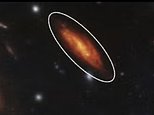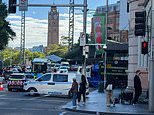
Astronomers have discovered mysterious ‘UFO galaxies’ that appear as red, glowing disc-shaped objects in the blackness of space.
They found evidence of 56 ‘Ultra-red Flattened Objects’ after analyzing data collected by NASA‘s James Webb Space Telescope (JWST), which had eluded older telescopes, like Hubble, for decades.
The UFO galaxies were likely hidden by clouds of dust and debris that surround them, masking the light from their inner star systems.
However, JWST features advanced technology, such as its infrared-light detection, enabled it to capture stunning images of these glowing discs, some located in regions closer to our own Milky Way galaxy than astronomers had thought they’d already mapped.
Drawing on these images and computer simulations, researchers at the University of Colorado Boulder (UCB) suggested that UFO galaxies are similar in size and shape to the Milky Way but are ‘much dustier.’
Lead author Justus Gibson said: ‘JWST allows us to see this type of galaxy that we never would have been able to see before.’
‘We thought that closer to us, we already had a pretty good understanding of all the types of galaxies there are,’ Gibson added. ‘It tells us that maybe we didn’t understand the universe as well as we thought.’
Gibson also explained that UFO galaxies appear red because they emit very little visible light. Most of the light escaping from these galaxies is infrared radiation, and the small amount of visible light they emit is at the limit of what human eyes can perceive.
Above, two images depicting the same region of space show how the ‘UFO galaxies’ evaded detection from past telescopes. The top image taken by the Hubble Space Telescope failed to spot the infrared heat signal that the James Webb Space Telescope image, below it, picked up
Researchers identified a total of 56 UFO galaxies – most likely hidden due to clouds of dust and debris that mask the light from their inner star systems. Above, four more examples of infrared emitting UFO galaxies that were hidden from Hubble (HST) but visible to the James Webb (JWST)
A suite of computer simulations, neural network emulators and mathematical models was used to determine the shapes of these large, red UFO galaxies.
The team concluded that they come in forms such as classic ‘flying saucers’ (discs) and rugby ball-shaped ‘prolate spheroids.’
Each of these massive, red light- and infrared radiation-emitting galaxies, the researchers discovered, contains roughly 50 times more dust than our own galaxy, the Milky Way.
Study co-author Erica Nelson remarked: ‘Why on Earth do these galaxies have so much more dust than all the other galaxies? Got me.’
The researchers considered data from the vast array of better-documented galaxies before feeling confident in their conclusion: the stars and planets within these UFO galaxies are hidden by thick clouds of dust.
The team rigorously compared this data to the total mass of stars in each UFO galaxy (its stellar mass) and the changes in the quality of light and infrared radiation emitted at each galaxy’s center compared to its edges.
The results provided a clear indication that the faint red light emitted by these UFO galaxies is due to masking by dust and debris—rather than the faint light typical of very distant galaxies billions of light-years away, which are thought to have formed during the universe’s earliest epochs.
‘UFOs have red colors throughout the extent of their bodies but still possess slight negative color gradients, with outskirts that are less red than the interiors,’ the said.
‘These color gradients are likely driven by increased central dust concentration and not by the ages of the stellar populations,’ they concluded in their study, published this October in The Astrophysical Journal.
Above, more examples of the 56 known UFO galaxies, with one comparatively ‘dust free’ galaxy in the top left, published by the researchers for the sake of comparison
Above, another bright-red UFO galaxy taken by James Webb. ‘It tells us that maybe we didn’t understand the universe as well as we thought,’ the study’s lead author Justus Gibson said
Changes in the gradients of red and infrared light, as well as similar measurements from nearby brighter and bluer galaxies, helped the team to also estimate the rate at which new stars form inside these UFO galaxies, another factor that might impact the light they emit.
‘The population of UFOs studied here are not extreme objects in regard to the stellar mass, SFR [star formation rates], or redshift,’ Gibson and his co-authors wrote.
The once hidden UFOs were thus simply, ‘thoroughly red objects whose optical faintness is largely driven by dust.’
‘They’re so visually striking,’ said Nelson, assistant professor of astrophysics at CU Boulder.
‘They’re enormous red disks that pop up in these images, and they were totally unexpected. They make you say, ‘What? How?”
Three other ultra-massive, red-light emitting galaxies dubbed ‘Red Monsters’ — each nearly as big as the Milky Way — were also discovered this month, much farther away from Earth and closer to the site of the Big Bang.
The international team of astronomers who published that find used similar methods to determine that their infrared radiating galaxies were most likely dust free, giants far away from Earth in both time and space.
Both the Red Monster and the UFO galaxies, the researchers noted, challenge current ideas of how galaxies form.
The Red Monsters show that galaxies formed much earlier than previously calculated and the UFOs show that gravity may not pool all the matter that swirls a young galaxy together into neatly defined planets and stars, leaving a lot of dust and debris behind.
‘They make you say: ‘What? How?” Dr Nelson said. ‘They’re so visually striking […] They’re enormous red discs that pop up in these images, and they were totally unexpected.’







